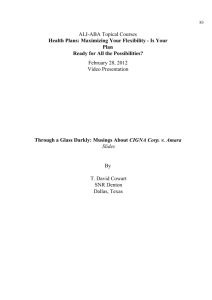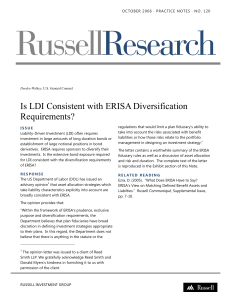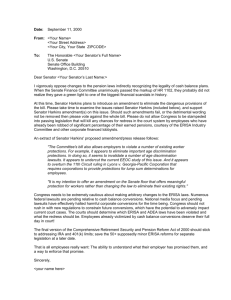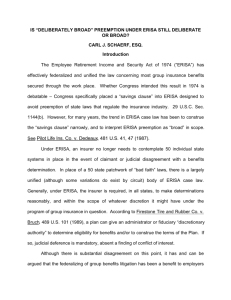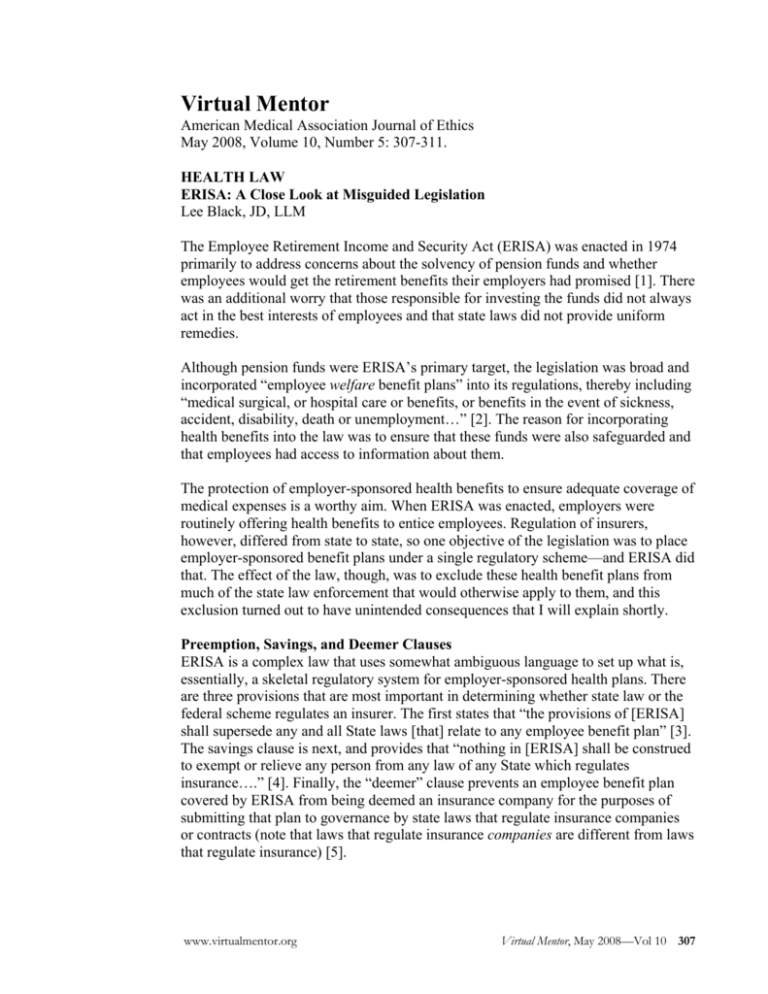
Virtual Mentor
American Medical Association Journal of Ethics
May 2008, Volume 10, Number 5: 307-311.
HEALTH LAW
ERISA: A Close Look at Misguided Legislation
Lee Black, JD, LLM
The Employee Retirement Income and Security Act (ERISA) was enacted in 1974
primarily to address concerns about the solvency of pension funds and whether
employees would get the retirement benefits their employers had promised [1]. There
was an additional worry that those responsible for investing the funds did not always
act in the best interests of employees and that state laws did not provide uniform
remedies.
Although pension funds were ERISA’s primary target, the legislation was broad and
incorporated “employee welfare benefit plans” into its regulations, thereby including
“medical surgical, or hospital care or benefits, or benefits in the event of sickness,
accident, disability, death or unemployment…” [2]. The reason for incorporating
health benefits into the law was to ensure that these funds were also safeguarded and
that employees had access to information about them.
The protection of employer-sponsored health benefits to ensure adequate coverage of
medical expenses is a worthy aim. When ERISA was enacted, employers were
routinely offering health benefits to entice employees. Regulation of insurers,
however, differed from state to state, so one objective of the legislation was to place
employer-sponsored benefit plans under a single regulatory scheme—and ERISA did
that. The effect of the law, though, was to exclude these health benefit plans from
much of the state law enforcement that would otherwise apply to them, and this
exclusion turned out to have unintended consequences that I will explain shortly.
Preemption, Savings, and Deemer Clauses
ERISA is a complex law that uses somewhat ambiguous language to set up what is,
essentially, a skeletal regulatory system for employer-sponsored health plans. There
are three provisions that are most important in determining whether state law or the
federal scheme regulates an insurer. The first states that “the provisions of [ERISA]
shall supersede any and all State laws [that] relate to any employee benefit plan” [3].
The savings clause is next, and provides that “nothing in [ERISA] shall be construed
to exempt or relieve any person from any law of any State which regulates
insurance….” [4]. Finally, the “deemer” clause prevents an employee benefit plan
covered by ERISA from being deemed an insurance company for the purposes of
submitting that plan to governance by state laws that regulate insurance companies
or contracts (note that laws that regulate insurance companies are different from laws
that regulate insurance) [5].
www.virtualmentor.org
Virtual Mentor, May 2008—Vol 10 307
What does all this mean? Most state contract and tort laws are superseded by
ERISA. State laws that specifically regulate insurance, however, generally still apply
to benefit plans covered by ERISA. For patients, this means that most meaningful
redress for harms caused by decisions of a benefit plan are unavailable.
Congress intended for ERISA to help employees by protecting their benefits. Yet,
discussion about ERISA provisions as they pertained to health benefits was sparse.
Originally narrow in scope, the language of the legislation was broadened to preempt
“state law relating to ‘any employee benefit plan’” [6]. There is virtually no evidence
of how Congress intended ERISA to relate to health benefits. Consequently, courts
have had to provide their own interpretations about when ERISA supersedes state
laws, and these interpretations have changed dramatically over the years.
ERISA and Managed Care Organizations
When ERISA was enacted, the health insurance system primarily reimbursed care
that was delivered on a fee-for-service basis; that is, insurers paid physicians
retrospectively for services that had been rendered at rates set by the physicians. In
the ensuing decades, managed care organizations (MCOs) emerged as a
reimbursement alternative to fee-for-service. Under managed care, physicians are
paid prospectively, with insurers generally paying physicians a specified amount per
patient per year, rather than by service. This system was designed to control costs by
giving physicians an incentive to limit services to those that are truly necessary. The
managed care system generated many disputes over which specific procedures the
insurer would reimburse, and when these disputes went to court, ERISA was often
invoked.
In early ERISA benefits decisions, courts took an expansive view of ERISA’s
preemption clause, deciding that Congress must have envisioned the broadest scope
for the federal law in order to prevent health plans from having to deal with
conflicting state laws. The seminal case of Pilot Life Insurance Co. v. Dedeaux in
1987, based on Pilot Life’s decision to terminate disability benefits, provided the
Supreme Court with an opportunity to examine the full extent of the ERISA
preemption clause [7]. Mr. Dedeaux claimed that Pilot Life breached its contract by
improperly denying coverage. Breach of contract is a state common law claim. The
court decided that the common law breach of contract claim, because it applied to all
contracts and not just insurance, was not a law “which regulates insurance” [8],
hence Dedeaux could not seek redress under state laws. The result of the ruling was
that lawsuits related to improper processing of benefits claims (benefits decisions)
fell entirely within the scope of ERISA preemption and were subject only to the civil
remedies ERISA provided, and not to state law remedies [9].
The real effect of Dedeaux when applied to MCOs is that they are liable only for the
cost of the denied treatment and, possibly, for attorney fees. Even if the insurer
denies coverage for a procedure or service that is explicitly covered and the insured
is injured because of the denial, there can be no damages for pain and suffering, and
no wrongful death claims if the insured dies while waiting for treatment.
308 Virtual Mentor, May 2008—Vol 10
www.virtualmentor.org
The immunity from state law claims still stands for employer-funded health plans
that wrongfully deny benefits. Some court decisions, however, have created a subtle
distinction between wrongful denial of benefits and treatment decisions. If an insurer
denies benefits on grounds that a particular treatment is not appropriate, claims filed
by the insured are still primarily subject to state laws. If the decision to deny
coverage is made by a treating physician employed by an MCO, the Supreme Court
has ruled that these are “mixed benefit-treatment decisions” and are covered under
ERISA [10].
The exact scope of MCO liability under ERISA is still in flux. A 2002 Supreme
Court decision upheld an Illinois statute that required independent medical review of
a denial by an insurer [11]. According to the court, this law regulated insurance and
therefore was not preempted by ERISA. Two years later, however, the Supreme
Court found that claims filed under the Texas Health Care Liability Act alleging that
MCOs improperly refused to cover a specific drug in one case and additional days of
hospitalization in another were entirely superseded by ERISA [12].
Clearly the law on MCO liability is not settled. One judgment held that certain
decisions made by insurers could be litigated under state law [11], but lawsuits based
on that decision were overridden 2 years later [12]. Overall, judicial decisions
holding that MCO liability is limited to remedies provided in ERISA protects
insurers substantially, but at some potential risk to physicians.
ERISA and Physicians
ERISA does not protect physicians from state law liability for malpractice or other
claims related to medical care. ERISA applies only to health plans and not to the
basic decision maker in the patient-physician relationship. This may be because
physicians were generally independent of insurers at the time the law was passed.
Today, however, the financial structure of physician-insurer relationships greatly
limits the autonomy of physicians. MCOs are much more involved in treatment
decisions than were fee-for-service insurers. The Supreme Court has recognized that
financial incentives may play a role in physicians’ decisions, but it has chosen not to
expand the scope of ERISA health plan liability on this basis [10]. Even if the
incentives tempt physicians to limit care, the Court has reasoned that, “the check on
this influence…is the professional obligation to provide covered services with a
reasonable degree of skill and judgment in the patient’s interest” [13].
What this means for physicians is that they may be the only truly liable party in a
claim for malpractice if a health plan covered under ERISA denies coverage. As
stated earlier, if a patient is injured because of a denial of a claim for benefits, the
remedy from the MCO is to pay the insured what the procedure would have cost if it
had been approved. In malpractice, however, damages can be both compensatory
(such as economic loss) and punitive, and physicians may have to bear the costs of
litigating and paying these claims.
www.virtualmentor.org
Virtual Mentor, May 2008—Vol 10 309
Conclusion
The Employee Retirement Income Security Act has an innocuous title; for those in
fear of loss of retirement benefits, the law has provided some reassurances that
benefit managers will be held to account. But the limited language concerning health
benefits has had far-reaching, broad effects on medical liability—and on the health
care system—that are not as beneficial as the title of the act makes it seem.
One objective of the medical malpractice system, whether or not one believes it
works, is to ensure that those who make poor decisions are accountable for their
mistakes. In the past, physicians were the primary decision makers in medicine and
generally faced sole responsibility for any injury to their patients. In the world of
managed care, plan administrators infringe upon the traditional autonomy of
physicians by reviewing and determining whether the care a physician recommends
is covered by the plan and whether it is necessary. Under ERISA, though, liability
risk for MCOs and physicians may not be proportional to their respective roles in
determining care.
ERISA has the effect of diminishing liability expertise for health plans and, along
with it, the responsible decision making that medical malpractice is intended to
encourage. This in turn may affect how physicians make decisions (for example,
electing more conservative treatments or only those deemed permissible by the
insurer) and permit insurers to act less conscientiously and less in the interest of
patient care.
It will be up to the courts to define further how ERISA impacts traditional remedies
and up to Congress to provide more specific guidelines. In an industry as heavily
regulated as health care, it takes more than the basic standards provided in ERISA to
ensure the safe and effective care of patients.
References
1. Rhodes S. ERISA strikes back: Aetna Health, Inc. v. Davila’s use of ERISA
to strike down the Texas Health Care Liability Act. Baylor L Rev.
2005;57:481-506.
2. Definitions. 29 USC sec 1002(1)(A).
3. Supersedure; effective date. 29 USC sec 1144(a).
4. Construction and application. 29 USC sec 1144(b)(2)(A).
5. Construction and application 29 USC sec 1144(b)(2)(B).
6. Strain JK, Kinney ED. The road paved with good intentions: problems and
potential for employer-sponsored insurance under ERISA. Loyola U Chi Law
J. 1999;31:29-68.
7. Pilot Life Insurance Co. v Dedeaux, 481 US 41 (1987).
8. Pilot Life at 50.
9. Persons empowered to bring a civil action. 29 USC sec 1132(a).
10. Pegram v Herdrich, 530 US 211 (2000).
11. Rush Prudential HMO, Inc. v Moran, 536 US 355 (2002).
310 Virtual Mentor, May 2008—Vol 10
www.virtualmentor.org
12. Aetna Health, Inc. v Davila, 542 US 200 (2004).
13. Pegram at 219.
Lee Black, JD, LLM, is a senior research associate for the Council on Ethical and
Judicial Affairs at the American Medical Association in Chicago. Prior to joining the
AMA, he was a staff attorney with the Legislative Reference Bureau in Springfield,
where he drafted legislation for the Illinois General Assembly.
The viewpoints expressed on this site are those of the authors and do not necessarily
reflect the views and policies of the AMA.
Copyright 2008 American Medical Association. All rights reserved.
www.virtualmentor.org
Virtual Mentor, May 2008—Vol 10
311


